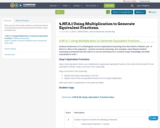
This resource will enable students to determine flawed reasoning when generating equivalent fractions using multiplication.
- Subject:
- Mathematics
- Material Type:
- Activity/Lab
- Assessment
- Homework/Assignment
- Date Added:
- 08/16/2018

This resource will enable students to determine flawed reasoning when generating equivalent fractions using multiplication.
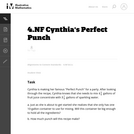
This is a task from the Illustrative Mathematics website that is one part of a complete illustration of the standard to which it is aligned. Each task has at least one solution and some commentary that addresses important asects of the task and its potential use. Here are the first few lines of the commentary for this task: Cynthia is making her famous "Perfect Punch" for a party. After looking through the recipe, Cynthia knows that she needs to mix $4\frac58$ gallons of f...
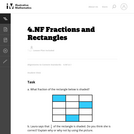
This is a task from the Illustrative Mathematics website that is one part of a complete illustration of the standard to which it is aligned. Each task has at least one solution and some commentary that addresses important asects of the task and its potential use. Here are the first few lines of the commentary for this task: What fraction of the rectangle below is shaded? Laura says that $\frac14$ of the rectangle is shaded. Do you think she is correct? Explain why or why n...
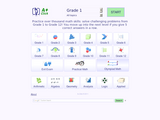
A+ Click is an interactive collection of more than 3700 math problems and answers for K-1 K-12 school program. It defines the personal level of math knowledge. You move up into the next level if you give 5 correct answers in a row. Practice makes perfect.
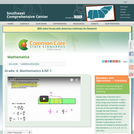
Explain why a fraction a/b is equivalent to a fraction (n × a)/(n × b) by using visual fraction models, with attention to how the number and size of the parts differ even though the two fractions themselves are the same size. Use this principle to recognize and generate equivalent fractions. (Grade 4 expectations in this domain are limited to fractions with denominators 2, 3, 4, 5, 6, 8, 10, 12, and 100.)

In this video segment from Cyberchase, the CyberSquad must locate a crystal with the highest fraction of orange color.
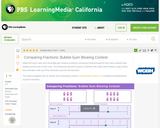
In this interactive activity adapted from Anneberg Learner’s Teaching Math Grades 3–5, compare fractions on number lines to determine which class of students wins bubble-gum-blowing contests.

In this Cyberchase video segment, Shari Spotter gets help from the CyberSquad in doubling a recipe for crumpets.

The following math lesson focuses on developing a deeper understanding of the value of fractions and allows the students to compare and order fractions while making decisions in a shopping experience. Learners will be better prepared to perform basic operations (+,-,x,/) once they have completed this module.
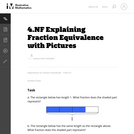
The purpose of this task is to provide students with an opportunity to explain fraction equivalence through visual models in a particular example.
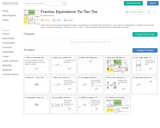
Show what you know about equivalent fractions and ordering by choosing three activities (in a row, column, or diagonal) to complete the tic-tac-toe board. Standards assessed: 3.NF.3a-d, 4.NF.1, 4.NF.2. This assessment was designed for adult basic education.
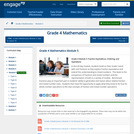
In this 40-day module, students build on their Grade 3 work with unit fractions as they explore fraction equivalence and extend this understanding to mixed numbers. This leads to the comparison of fractions and mixed numbers and the representation of both in a variety of models. Benchmark fractions play an important part in students ability to generalize and reason about relative fraction and mixed number sizes. Students then have the opportunity to apply what they know to be true for whole number operations to the new concepts of fraction and mixed number operations.
Find the rest of the EngageNY Mathematics resources at https://archive.org/details/engageny-mathematics.
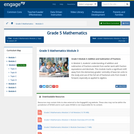
In Module 3, students' understanding of addition and subtraction of fractions extends from earlier work with fraction equivalence and decimals. This module marks a significant shift away from the elementary grades' centrality of base ten units to the study and use of the full set of fractional units from Grade 5 forward, especially as applied to algebra.
Find the rest of the EngageNY Mathematics resources at https://archive.org/details/engageny-mathematics.

In this activity, students will use cookies to simulate the distribution of our nonrenewable resources (energy). Then, they will discuss how the world's growing population affects the fairness and effectiveness of this distribution of these resources and how engineers work to develop technologies to support the population.
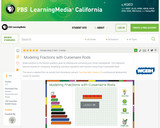
In this interactive activity adapted for grades 3–5 from Annenberg Learner’s Teaching Math Grades 6–8, use virtual Cuisenaire® Rods to represent fractions and to perform operations with fractions.
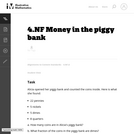
This task is designed to help students focus on the whole that a fraction refers to. It helps students to realize that two different fractions can describe the same situation depending on what you choose to be the whole.

(Nota: Esta es una traducción de un recurso educativo abierto creado por el Departamento de Educación del Estado de Nueva York (NYSED) como parte del proyecto "EngageNY" en 2013. Aunque el recurso real fue traducido por personas, la siguiente descripción se tradujo del inglés original usando Google Translate para ayudar a los usuarios potenciales a decidir si se adapta a sus necesidades y puede contener errores gramaticales o lingüísticos. La descripción original en inglés también se proporciona a continuación.)
En el módulo 3, la comprensión de los estudiantes de la adición y la resta de las fracciones se extiende desde el trabajo anterior con equivalencia de fracción y decimales. Este módulo marca un cambio significativo lejos de la centralidad de los grados elementales de las diez unidades de base al estudio y el uso del conjunto completo de unidades fraccionarias desde el avance de grado 5, especialmente como se aplica al álgebra.
Encuentre el resto de los recursos matemáticos de Engageny en https://archive.org/details/engageny-mathematics.
English Description:
In Module 3, students' understanding of addition and subtraction of fractions extends from earlier work with fraction equivalence and decimals. This module marks a significant shift away from the elementary grades' centrality of base ten units to the study and use of the full set of fractional units from Grade 5 forward, especially as applied to algebra.
Find the rest of the EngageNY Mathematics resources at https://archive.org/details/engageny-mathematics.

(Nota: Esta es una traducción de un recurso educativo abierto creado por el Departamento de Educación del Estado de Nueva York (NYSED) como parte del proyecto "EngageNY" en 2013. Aunque el recurso real fue traducido por personas, la siguiente descripción se tradujo del inglés original usando Google Translate para ayudar a los usuarios potenciales a decidir si se adapta a sus necesidades y puede contener errores gramaticales o lingüísticos. La descripción original en inglés también se proporciona a continuación.)
En este módulo de 40 días, los estudiantes se basan en su trabajo de grado 3 con fracciones unitarias mientras exploran la equivalencia de fracción y extienden esta comprensión a números mixtos. Esto lleva a la comparación de fracciones y números mixtos y a la representación de ambos en una variedad de modelos. Las fracciones de referencia juegan un papel importante en la capacidad de los estudiantes para generalizar y razonar sobre la fracción relativa y los tamaños de números mixtos. Luego, los estudiantes tienen la oportunidad de aplicar lo que saben para ser cierto para las operaciones de números enteros a los nuevos conceptos de fracción y operaciones de números mixtos.
Encuentre el resto de los recursos matemáticos de Engageny en https://archive.org/details/engageny-mathematics.
English Description:
In this 40-day module, students build on their Grade 3 work with unit fractions as they explore fraction equivalence and extend this understanding to mixed numbers. This leads to the comparison of fractions and mixed numbers and the representation of both in a variety of models. Benchmark fractions play an important part in students ability to generalize and reason about relative fraction and mixed number sizes. Students then have the opportunity to apply what they know to be true for whole number operations to the new concepts of fraction and mixed number operations.
Find the rest of the EngageNY Mathematics resources at https://archive.org/details/engageny-mathematics.
![OREGON MATH STANDARDS (2021): [4.NF]](https://img.oercommons.org/160x134/oercommons/media/courseware/lesson/image/13138_ODE_Math_Logo_2018-H_color_BvjqVNy.png)
The intent of clarifying statements is to provide additional guidance for educators to communicate the intent of the standard to support the future development of curricular resources and assessments aligned to the 2021 math standards. Clarifying statements can be in the form of succinct sentences or paragraphs that attend to one of four types of clarifications: (1) Student Experiences; (2) Examples; (3) Boundaries; and (4) Connection to Math Practices.

In this video segment from Cyberchase, Jackie and Inez figure out how to break an Electro-Root into 2/5, one of the ingredients for the antidote to Motherboardë_í__ virus.